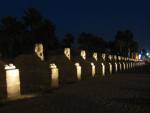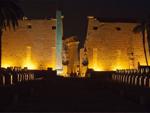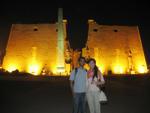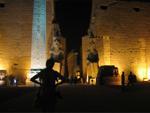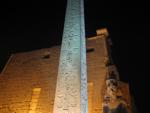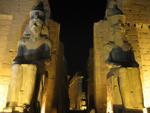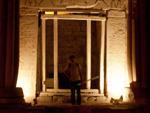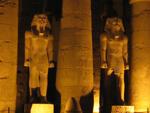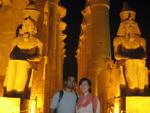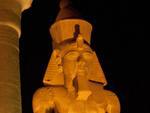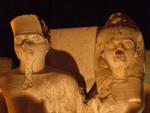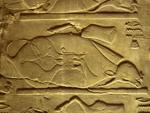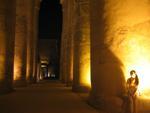From Aswan we caught a train to Luxor arriving late in the afternoon. After the Pyramids of Giza, Luxor is the most visited tourist destination in Egypt. Luxor sits on the site of the Ancient Egyptian city of Thebes, with the majority of the city on the East Bank of the Nile and the Tombs and Temples on the West Bank Necropolis. We gave ourselves two days only to visit all of Luxor’s sites, it would be rushed.
thydzikgooglemap(http://sonyaandtravis.com/maps/egypt-2011-aswan-to-luxor.xml)
On arrival we checked into our hotel and then made our way to Luxor Temple, situated in the heart of Luxor. On arrival it was already sunset but the temple was lit up which provided a different view, and one that wasn’t part of a sound and light show. Entering the temple we were presented with the first pylon on the left and Avenue of Sphinxes on the right. The Avenue of Sphinxes now consisting of fifty or so sphinxes, originally connected the Temple of Luxor with the Temple of Karnak, a little over two kilometres away. The government is attempting to restore the avenue, but it unfortunately means destroying existing local housing.
Walking along the Avenue of the Sphinxes towards Luxor Temple gave a magnificent view of the first pylon. A pylon is a monumental gateway, placed at the entrances to rooms of temples. The pylons would be covered in Egypt stories chiselled in to the stone. The Luxor Temple first pylon was named Pylon of Ramesses II and led to the Great Court baring the same name. Outside the first pylon was also a large red granite obelisk, obelisks where commonly found in pairs at the entrance to temples. The missing partner was gifted to France and is standing at the centre of the Place de la Concorde in Paris.
The Great Court of Ramesses II consists of columns with capitals of closed papyri buds (representing Lower Egypt) interspaced with statues. From the Great Court is the Colonnade consisting of two magnificent rows of columns with capitals of lotus flowers (representing Upper Egypt). Before entering the temple sanctuaries was the Sun Court of Amenhotep III.
thydzikgooglemap(http://sonyaandtravis.com/maps/egypt-2011-luxor-temple.xml,s)
On the way back to the hotel we stopped to have dinner at a corner restaurant. We tried karkadé (Hibiscus tea) which is very popular in Egypt.





































































































